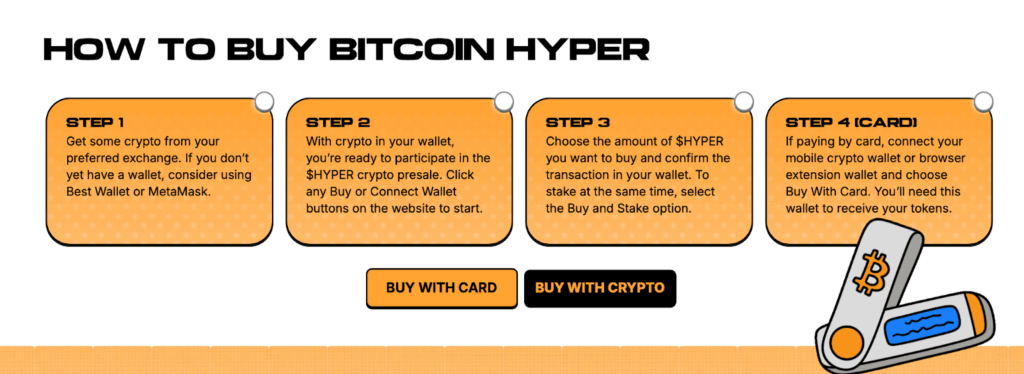Bitcoin’s dominance is undisputed, but its slow network leaves room for innovation. With Bitcoin Hyper’s Layer-2 attracting whales and offering Solana-grade performance, could it be the next crypto to explode in Uptober?
Bitcoin has entered yet another defining moment in its history. Trading around $118,000 after recently hitting an all-time high of $124,000, the world’s largest cryptocurrency boasts a market cap of $2.34 trillion. Its strength as an asset is clearer than ever, but so are its shortcomings.
The issue is scalability. The Bitcoin blockchain was designed to process only about seven transactions per second (TPS). While that design emphasises security and decentralisation, it means that as more users join the network, transactions pile up and fees climb higher. What should take ten minutes often stretches into an hour or more.
For long-term holders, the delay is insignificant. If your strategy is to store Bitcoin as “digital gold,” an extra hour waiting for a block confirmation hardly matters, but for Web3 builders, DeFi users and anyone expecting Bitcoin to serve as a day-to-day payment system, the limitations are glaring. In a world where Ethereum averages over 100 TPS and Solana handles more than 65,000 TPS, Bitcoin is at risk of being left behind in terms of utility.
This dynamic illustrates the so-called scalability trilemma: the more decentralised and secure a blockchain becomes, the harder it is to scale. If Bitcoin is to remain relevant beyond its role as a store of value, it must find a way to evolve. That’s where Bitcoin Hyper steps in.
Why Bitcoin Hyper Matters
Bitcoin Hyper is a new Layer-2 solution designed to relieve the pressure on the Bitcoin network. By integrating Solana’s Virtual Machine (SVM), it aims to dramatically boost transaction speeds and reduce costs while preserving Bitcoin’s core security.
Here’s how it works: users send their BTC to a canonical bridge, which locks the funds and issues wrapped BTC on the Bitcoin Hyper Layer-2. Transactions are then processed at near-instant speed on this secondary layer and periodically settled back on the Bitcoin main chain. The result is a system where Bitcoin remains the anchor of value but gains an execution environment more akin to Solana.
The Layer-2 model also unlocks new possibilities. Developers can build smart contracts, DeFi protocols, NFTs and even meme coins directly within the Bitcoin ecosystem. For the first time, Bitcoin can offer the sort of experimental, high-speed environment that has long been the domain of Ethereum and Solana.
Whale Activity Signals Confidence
Institutional investors and whales have already started to take notice. The Bitcoin Hyper presale has raised more than $19.8 million, with single whale buys of $12,300 and $10,900 recorded in just the past 24 hours. These numbers may seem modest compared to Bitcoin’s trillion-dollar market cap, but they are significant for a project still in presale.
The attraction is twofold. First, Bitcoin Hyper offers a clear use case: it fixes Bitcoin’s slow speeds without sacrificing security. Second, its native token, $HYPER, is not just a speculative play. It powers the network by fueling transactions, governance, staking and access to dApps. The token’s built-in utility creates organic demand beyond hype cycles.
Currently priced at $0.013015, $HYPER offers staking rewards of around 60% APY, a rate that has enticed both retail and whale investors.
Bitcoin’s Scalability Problem in Context
To understand why Bitcoin Hyper is generating such buzz, it helps to revisit Bitcoin’s structural issues. Each Bitcoin block has a fixed size, which limits the number of transactions it can carry. The result is a bottleneck where fees surge and processing times stretch whenever demand rises.
Ethereum faced similar issues but developed Layer-2s like Arbitrum and zkSync, which now hold billions in total value locked. Solana sidestepped many of these problems by building for speed and throughput from the start. Bitcoin, by contrast, has remained conservative – prioritising decentralisation and security but at the cost of flexibility.
This conservatism has benefits. Bitcoin is considered the most secure blockchain in existence and its proof-of-work consensus has withstood countless stress tests, but in the rapidly evolving world of Web3, security alone is not enough. Users demand speed, affordability and adaptability. Bitcoin Hyper is attempting to reconcile those competing needs by adding scalability without undermining Bitcoin’s foundation.
Why Bitcoin Hyper Could Be the Next Crypto to Explode
Every crypto cycle tends to spotlight projects that solve pressing industry problems. Ethereum once captured attention as the first smart contract platform, while Solana surged on the promise of low fees and high throughput. In 2025, the pressure point is Bitcoin’s usability.
Bitcoin Hyper positions itself as the bridge between Bitcoin’s vast liquidity and the innovation of decentralised applications. By tapping into wrapped BTC and extending its use cases into DeFi, NFTs and beyond, Bitcoin Hyper could unlock dormant demand in the Bitcoin ecosystem.
For whales and retail alike, the appeal lies in first-mover advantage. Bitcoin Hyper is among the first serious Layer-2 projects purpose-built for Bitcoin that incorporates Solana-grade performance. In crypto, being early to such a shift can mean exponential returns, which is why investor attention has sharpened in recent weeks.

Uptober Momentum and Market Cycles
The timing could not be more favorable. Historically, Bitcoin rallies in the final quarter of the year. Uptober, as traders call it, has often delivered strong gains, with average Q4 returns hovering above 40%. If Bitcoin continues to climb through the end of 2025, projects linked to its growth – particularly those that expand its utility – could see amplified gains.
That backdrop makes Bitcoin Hyper’s presale success and whale participation especially noteworthy. The project is not trying to compete with Bitcoin but to enhance it. If successful, it could transform Bitcoin from a store of value into a fully usable Web3 platform and in doing so, become the next crypto to explode.
Adapting to Stay Dominant
Bitcoin’s journey has always been one of evolution. It started as a niche payment experiment, became a store of value and now sits at the center of institutional adoption. Each stage has required new infrastructure to sustain growth.
Bitcoin Hyper may represent the infrastructure needed for Bitcoin’s next chapter. By resolving scalability without sacrificing decentralisation and by introducing new functionality while preserving trust in the base chain, it attempts to square the trilemma that has long defined blockchain design.
Whether $HYPER ultimately fulfils its ambitious vision remains to be seen, but its emergence highlights a broader truth: Bitcoin is not immune to the demands of modern crypto markets. To remain dominant, it must adapt.
INVEST IN THE TOP BITCOIN LAYER 2, BITCOIN HYPER, NOW
Bitcoin Hyper is more than a speculative presale – it is an attempt to fix one of Bitcoin’s oldest problems. Its integration of Solana’s Virtual Machine, zero-knowledge rollups and a canonical bridge creates an execution environment that could finally bring speed and flexibility to Bitcoin.
With whales buying in, retail investors staking early and Uptober momentum fueling the broader market, Bitcoin Hyper is well-positioned to capture attention as the next crypto to explode.
For Bitcoin itself, the project may mark the beginning of a long-awaited second act – one where security meets scalability and where the world’s first cryptocurrency evolves into a platform for everything Web3 has to offer.
Disclaimer: This article is for informational purposes only and does not constitute financial advice. Cryptocurrency investments are volatile and risky. Always conduct your own research before investing.













